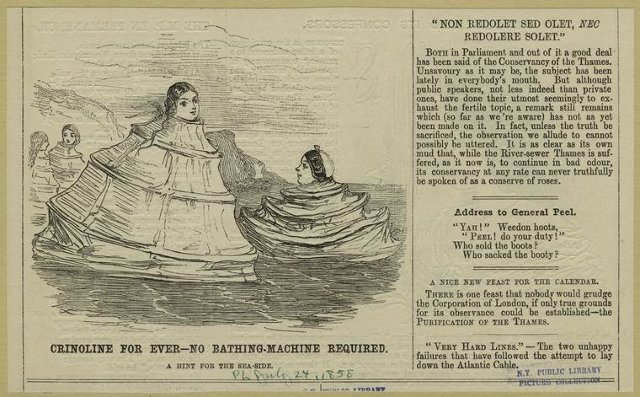Compared to our barely clad, spaghetti-strapped swimsuit styles, the bathing costumes of the 18th and 19th century seem laughably prudish. But those days, people worried that glimpsing more than a sliver of a woman's ankle might give onlookers the vapors. This was such a concern, in Georgian and Victorian times (roughly 1714 to 1901), that entire fleets of bathing machines were designed to prevent anyone from seeing a woman in her swimsuit before she slipped into the waves.
European beaches began filling up with bathing machines starting in the 1750s, and those machines stuck around, remarkably, until the 1920s. They resembled wooden changing booths, with wheels and wooden steps that led inside. In a nutshell: A woman walks into the booth, changes, and when she's ready a horse gets hitched to the machine and drags her out to sea, at which point the machine becomes a floating changing buoy. Once the machine plunged far enough out into the ocean waves, the woman could quickly dive off the float. And so it went. Thanks to these boxy hideaways, no one got scandalized by said woman's (decidedly unsexy) bathing tarpaulin.

An account written in 1847 describes the rather plush interior of one of these machines:
The interior is all done in snow-white enamel paint, and one-half of the floor is pierced with many holes, to allow of free drainage from wet flannels. The other half of the little room is covered with a pretty green Japanese rug. In one corner is a big-mouthed green silk bag lined with rubber. Into this the wet bathing-togs are tossed out of the way. There are large bevel-edged mirrors let into either side of the room, and below one juts out a toilet shelf, on which is every appliance. There are pegs for towels and the bathrobe, and fixed in one corner is a little square seat that when turned up reveals a locker where clean towels, soap, perfumery, etc. are stowed. Ruffles of white muslin trimmed with lace and narrow green ribbons decorate every available space.
To be fair, when they originally debuted in the 1750s, bathing machines weren't quite as prudish as they ultimately became: In their earliest days, it was still common for men and women alike to swim nude. But by the time Victorian mores took hold (1837, per Queen Victoria's reign), bathing machines were horrifyingly ubiquitous on European and American beaches despite the fact that the swimsuits of the time revealed barely anything at all.

By the 1920s (whew), bathing machine were all but extinct. Yet even today, you can sometimes see bathing machines on the beach. Horses may not drag the carriages to sea anymore, with women shunted inside, but some of these bathing machines survive as beachside huts.
For more information on Victorian bathing machines, read this great post on Messy Nessy Chic.